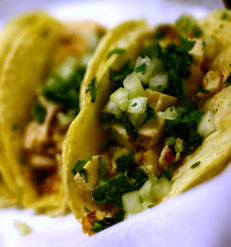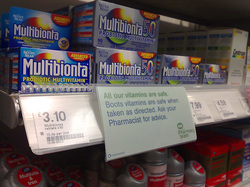 Black Bean, Rice, and Yam Wraps Feeling the chocolate coma from Easter weekend? Here's a recipe to get a little more veg back in your diet that tastes great and is easy to make. Serves 4-6 1 ½ cups short grain brown rice ½ cup sweet brown rice 4 cups water pinch sea salt 1 large yam, cut into large chunks 3 cups cooked black beans, or 2 cans 1 large avocado, mashed salsa mixed greens brown rice tortillas Directions: 1. Preheat the oven to 425 F 2. To cook rice, place the short grain rice, sweet rice, water and sea salt into a 2-quart pot, cover, and bring to a boil. Reduce heat and simmer for about 45 minutes. Remove pot from heat and let stand for at least 10 to 15 minutes. 3. While the rice is cooking, place the yam chunks into a small casserole dish, fill with about ½ inch of water, place the lid on the casserole dish and bake in the oven for 40-45 minutes, or until the yams are very tender. Remove skins from yams and slightly mash them with a fork. 4. To assemble a wrap, lay tortilla flat onto a plate and place a small amount of rice in the middle of it, add some cooked black beans, some mashed yam, mashed avocado, salsa, and some mixed greens. Fold the ends in and roll. Note: If using the brown rice tortillas make sure you warm them before use because they often fall apart when cold. References: Segersten, A. & Malterre, T. The Whole Life Nutrition Cookbook. Blueberry Almond Oatmeal. 2nd Ed. Whole Life Press.
1 Comment
 Gastroesophageal Reflux Disease (GERD) Many people in the Western world suffer from heartburn on a daily basis. Of those individuals, approximately 20-40% of them have GERD (Gastrointestinal Reflux Disease). The symptoms result from exposure to gastric contents causing esophageal irritation. For most people, the lower esophageal sphincter (LES) is often weakened or other interfering factors can prevent it from closing properly.
Conventional Treatment Typical treatment of heartburn symptoms is the use of antacids (eg. Tums) or stronger medications that can block or suppress the production of hydrochloric acid (HCl). Naturopathic Treatment Usually a combination of nutritional, dietary and lifestyle treatment is used to address GERD. If the patient is compliant, usually treatment is very effective. Almost every GERD patient will need to identify and avoid foods and medications that trigger symptoms. Most people also find eating smaller meals with more frequency (6 small meals as opposed to 3 larger meals) and not lying down immediately following a meal is also beneficial. Dietary and Drug Triggers of GERD
Nutrients and Herbs
Melatonin: Found to be capable of protecting the esophagus and mitigating the effects of many inflammatory mediators. One study where individuals were treated with melatonin and a few other nutrients (l-tryptophan, Vitamin B6, folic acid, Vitamin B12, methionine, and betaine) or omeprazole, and those treated with melatonin experienced 100% resolution of symptoms compared to 65.7% in those treated with omeprazole. Phosphatidylcholine (PC): Cell membranes are typically rich sources of endogenous PC, which usually acts as a reservoir for free choline. Free choline is important for acetylcholine synthesis, and acetylcholine has been linked to increased closure of the LES. Licorice Root (Glycyrrhiza glabra): Considered a demulcent, meaning it coats, soothes and protects tissue. Commonly used for a number of gastric concerns including GERD. Marshmallow (Althaea officinalis): Another good demulcent and anti-inflammatory herb that is particularly known for soothing inflamed or irritated mucous membranes. There is no one set formula for preventing GERD, but through proper treatment and working with your health care provider you can learn to manage this condition well. Talk to your Naturopathic Doctor today about getting assessed and treated if needed, and as always talk to your health care provider before beginning any new medication or supplement. Note: There are many possible causes of chest pain, including more severe conditions such as a heart attack. If you are uncertain of the cause of your chest pain make sure you see your doctor to get it evaluated as soon as possible. References: Godfrey A. & Saunders P.R. (2010) Principles & Practices of Naturopathic Botanical Medicine: Volume I: Botanical Monographs. Central Nervous System, pg. 161-163. CCNM Press. Prousky J. (2008) Principles & Practices of Naturopathic Clinical Nutrition. Gastroesophageal Reflux Disease (GERD), pg. 126-129. CCNM Press.  Iron One of the nutrients I get a lot of questions about in general is iron. Newly pregnant women are particularly concerned about their iron status and what impact that may have on their baby. In this blog, I will discuss why you don't need to worry too much about baby and how to ensure you both get enough. First thing to remember about the growing fetus is that it is very good at getting what it needs. Baby will stock pile as much iron as it needs in utero. Even for mothers with iron deficiency anemia, which affects almost 50% of pregnant women, studies have found that their babies were still born with sufficient iron. In general, healthy full term babies have enough iron stores to last for the first 6-12 months of life, especially exclusively breastfed babies. However, if you are found to be iron deficient it's still important to supplement because you need sufficient iron just as much as your growing baby. Why is Iron Important? During pregnancy, iron requirements double in order to build new red blood cells (RBCs) in Mom and the developing fetus. Iron also plays a role in cognitive and behavioural maturity, making hemoglobin and protein in RBCs that delivers oxygen to the body’s organs, muscles and tissues. Babies at risk for low iron stores: premature born (biggest grab for iron is in the third trimester), low birth weight babies (less than 6 lbs, 6 oz), babies born to mothers with poorly controlled diabetes during pregnancy, and babies fed cow’s milk instead of breast milk or formula during the first year. Iron Sources and Requirements If you look at the following, you will see that the daily requirement for iron is not a huge amount. The problem is, many people do not reach it daily and over time this will create a deficiency. Iron can be divided into two forms, heme and non-heme. Our bodies can absorb heme sources (15-35%) better than non-heme (2-20%). Dietary sources of heme are meat, chicken, and fish. Non-heme is in these and non meat foods (eggs, dairy, fruits and veggies). For the little ones iron has it’s highest absorption rate from breast milk (50-70%) due to the presence of Vitamin C and high levels of lactose in breast milk, as well as proteins lactoferrin and transferrin, help to increase absorption.
Other sources and their absorption rates: o Iron fortified dairy formula: 3-12 % o Iron fortified soy formula: 1-7% o Iron fortified cereal: 4-10% o Cow’s milk: 4-10% When supplementing to correct iron deficiency use a non-ferrous sulphate supplement (ferrous gluconate, chelate, or fumarate form). Ferrous sulphate is one of the most commonly used in supplements because it’s inexpensive, but it’s not absorbed well (absorption rate is only 10%). Make sure you take your iron with Vitamin C, as it increases the uptake of iron, and between meals. Calcium, black tea and some herbals [chamomile and peppermint], coffee or cocoa, oxalates found in some dark leafy greens, and other minerals can bind with iron and decrease absorption. If you're concerned about your iron status then talk to your Naturopathic Doctor today about putting together a plan that addresses your individual needs. References: Phillipson-Webb, L. 2010. Sprout Right: Nutrition from Tummy to Toddler. Penguin Canada. Romm, A. 2003. Naturally Healthy Babies and Children: A Commonsense Guide to Herbal Remedies, Nutrition, and Health. Celestial Arts. Skowron, JM. 2009. Fundamentals of Naturopathic Pediatrics. CCNM Press. Print. |
Sarah Connors
I am a Naturopathic Doctor and Doula providing care in the Kitchener-Waterloo area. I have a passion for helping people with their health issues and improving the birth experience for Moms, and their babies. I also have a life long love affair with soccer, curling, and the alto saxophone. Archives
November 2020
Categories
All
|
Photos from Rural Royalty, manu flickr2010, Ryan Dickey, wocintechchat, huskyte77, paulswansen, Black Room Photography, harum.koh, Emery Co Photo, JeepersMedia, BrownGuacamole, wellnesswildflower, JeepersMedia, vastateparksstaff, colindunn, seelensturm, /\ \/\/ /\, 50mm.za, The Simpsons (Lee, Shirley, Luke and Rachel), AGRONAUTI, aivas14, Jonathan Rolande, winnifredxoxo, juhansonin, osseous, nan palmero, Theo Crazzolara, brianfagan, TP studio, wuestenigel, torbakhopper, anka.albrecht, Michael Stern, [-ChristiaN-], franchiseopportunitiesphotos, terren in Virginia, nateOne, barnimages.com, Dun.can, wuestenigel, @lattefarsan, amandabhslater, aphrodite-in-nyc, nutritionaldoublethink, Anne Worner, donnierayjones, mikecogh, angeloangelo, Rob.Bertholf, getaiwan, Lida Rose, matsuyuki, SurFeRGiRL30, marcoverch, amsfrank, mdaltry, nutrition education, Mike Prince, Edsel L, Neighborhood Nini, philipp.alexander.ernst, Mediocre2010, homethods, quinn.anya, Gamma Man, katerha, Eric Kilby, National Institutes of Health (NIH), rcmd_cfdfw_5_2, curtis palmer, Ray in Manila, frankieleon, Airsoftpal.com, byzantiumbooks, cchana, Brian Legate, Matt Lavin, BradHinton, monpetitchouphotography, wuestenigel, alexisjordanlewis, ByEPhotos, erix!, RLHyde, return the sun, quinn.anya, mliu92, frankieleon, loudista, Lyn Lomasi, upslon, derrickbrutel, cchana, National Institutes of Health (NIH), watts_photos, marcoverch, derrickbrutel, francesbean, weegeebored, Airsoftpal.com, Etwood, wu_135, shixart1985, Ingrid Taylar, VeritasFotografie, BioDivLibrary, emmanuelmorales1, Thanks for 1.5 Million Views!!, Will Merydith, reader of the pack, RoxyHobbs, Khanelle Prod' Medias, storyvillegirl, agromonitor, Arenamontanus, six:eleven, cote, SweetOnVeg, nenoirenediaz, lucianvenutian, markhillary, anotherlunch.com, inkknife_2000, archibald jude, rawtrigger, Imaginary Museum Projects: News Tableaus, Pavel P., Courtney Emery, Thien Gretchen, physiognomist, bark, Michigan Municipal League (MML), alberth2, Merelymel13, neofob, Care_SMC, Parker Knight, B*2

 RSS Feed
RSS Feed
